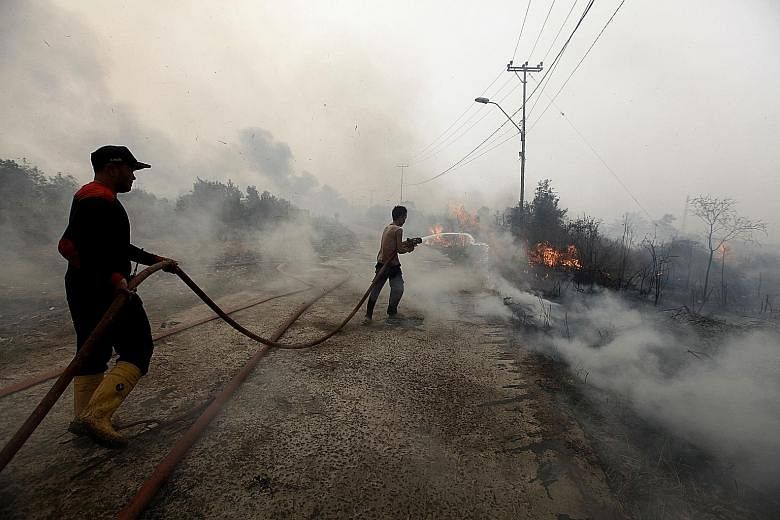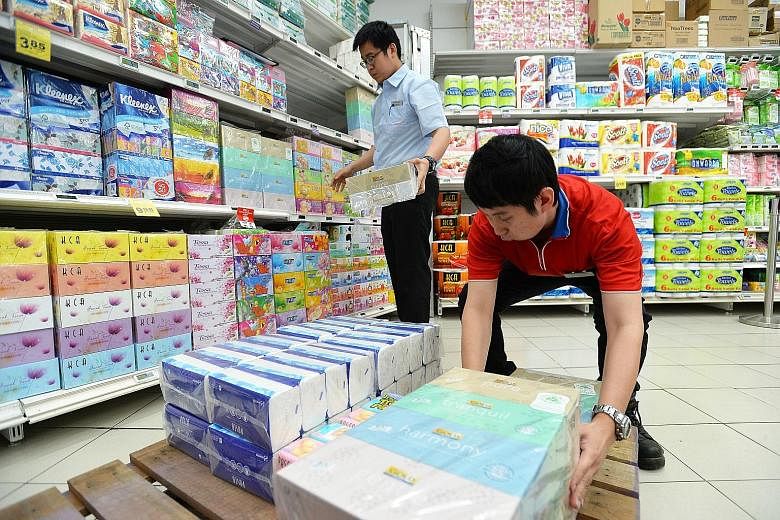More companies in Singapore have distanced themselves from Asia Pulp and Paper (APP) over its supposed links to the haze. As of yesterday, 114 had declared that they were not using products of firms such as APP, which has been accused of having fires on its concessions.
APP suggests it is paying a price for being too open.
It has made available all of its suppliers' concession maps to the Washington-based World Resources Institute (WRI) "as part of our commitment to transparency", APP managing director of sustainability Aida Greenbury told The Straits Times.
Since other pulp and paper producers and oil palm and agricultural firms do not share such information, observers say it is hard to nail them if there are fires on their concessions. It also gives the "incorrect impression that APP has the most fires on its suppliers' concessions", Ms Greenbury added.
APP - Indonesia's largest pulp and paper firm - came under the spotlight last month, when the National Environment Agency (NEA) served it a notice under the Transboundary Haze Pollution Act, to request that it provide information on its subsidiaries and measures taken by its suppliers in Indonesia to put out fires on their concession lands.
Of the firms against which NEA acted then, APP was the only one with a presence in Singapore.
The notice sparked a chain reaction. The Singapore Environment Council suspended the use of its green label on APP products, and supermarkets such as FairPrice and Giant pulled APP products off their shelves.
There were also calls for people to boycott APP products, which range from Paseo brand toilet rolls to FairPrice brand facial tissue.
So has APP been made a scapegoat for being transparent, and are other culprits getting away?
Singapore Management University law don Eugene Tan said that there may well be other culprits who are escaping the shame and the blame. "But what the likes of APP cannot avoid (acknowledging) is that the land that they own or have control over is on fire," he said.
TRANSPARENCY
Still, the situation on the ground is murky. Concession maps are key to fighting the haze crisis, as they could help to identify the culprits whose lands are on fire.
The government in Jakarta has added to the difficulty. In August, the Indonesian government said concession maps are classified information and it is a breach of law to disclose them even on a government-to-government basis. Singapore has also made repeated requests for the Indonesian government to share information on errant companies to no avail.
The WRI runs Global Forest Watch Fires, an online forest monitoring and fire alert system that provides detailed mappings and analyses of forest fires around the world.
The platform uses satellite data, wind direction data as well as maps of land cover, protected areas and concession areas for commodity production, some of which are submitted by companies directly, while others are shared as part of public government data sets.
A spokesman for WRI said APP has shared online not just its own concession maps, but also those of its suppliers. "Other companies, including APP's competitors, have not been so transparent and we hope these companies will be more forthcoming to help all find a solution to the crisis," he added.
Nor is the government in Jakarta helping. Environmental group Greenpeace told The Straits Times: "RSPO (Roundtable on Sustainable Palm Oil) member palm oil companies - which indicated they planned to release concession maps to the public and to organisations such as WRI - were threatened with legal consequences by the Indonesian Ministry of Agriculture if they released such information."
WHERE'S THE FIRE?
It depends on who you ask.
Ms Greenbury cited WRI data showing that only 16 per cent of fire alerts between July 1 and Oct 8 this year were from pulpwood plantations. For the same period, 20 per cent of fire alerts were on palm oil concessions, 8 per cent on logging concessions and 56 per cent from outside concessions, she said.
The implication: Why blame APP when pulpwood plantations were responsible for so few of the fires?
But wait. Citing longer-term data from Jan 1 to Oct 22 this year, WRI said that while 12 per cent of fire alerts in Indonesia had occurred on pulpwood concessions, the picture was different when one zoomed in on Sumatra, which is responsible for pushing much of the haze towards Singapore. In Sumatra, 30 per cent of fire alerts came from pulpwood concessions.
In Kalimantan, on the other hand, more fires occur in oil palm concessions (23 per cent) than pulpwood (8 per cent) ones, the data showed.
Data from Eyes on the Forest, a World Wide Fund for Nature (WWF) collaboration, showed the Sinar Mas Group/APP corporate group has had the highest number of hot spots this year. APP is a unit of the Sinar Mas Group.
WWF Singapore director of communications Kim Stengert pointed out that Sinar Mas Group/APP had 39 per cent of all high-confidence hot spots in Sumatra, and 53 per cent of high-confidence hot spots on Sumatra's peat this year.
So does that make APP the big culprit? Greenpeace said that, as it is the biggest concession holder in Indonesia with a legacy of deforestation, and the only one that released accurate concession maps, it is not surprising that APP hosted most of the hot spots.
But it added: "We cannot tell you how bad the situation is for other companies because none of them volunteered the same level of information. It makes you wonder, what do they have to hide?"
PEATLAND FIRES
At the heart of the problem are the fires in Indonesia's peatland.
Greenpeace South-east Asia researchers looked at 112,000 fire hot spots recorded from Aug 1 to Oct 26 this year. Almost half the fires were on peat soils, which make up only 10 per cent of Indonesia's land mass.
"There can be no question that the root cause of the fire crisis is decades of forest and peatland destruction by pulp and palm oil companies," said Indonesia forest campaigner at Greenpeace South-east Asia Teguh Surya.
The organisation is demanding an immediate ban on further development in the peatland and an end to clearing forests there. It even wants critical peatland areas re-flooded to reduce the risk of more fires.
Interestingly, it is the much- maligned APP - which Greenpeace says has a legacy of deforestation in Sumatra - that recently implemented a peat policy and action plan to start protecting and restoring peatlands across its suppliers' operations.
Ms Greenbury also told The Straits Times that APP brought in two amphibian water-bombing planes, each with a 12,000-litre water capacity, to help fight fires in South Sumatra and beyond.
While companies like APP have acted, observers say that it will require strong political will to get other culprits to do the right thing.
Said SMU's Prof Tan: "Once you have political will, then the issues that come with enforcement will be avoided. Until then, even our efforts to enforce our Transboundary Haze Pollution Act are crippled without the cooperation of the Indonesian authorities.
"It is not that there are no laws, or that the laws are inadequate in Indonesia. It's just that they are not being enforced."
Dr Jonatan Anderias Lassa from Nanyang Technological University's S. Rajaratnam School of International Studies added that governments have a role to play in reducing the risk of haze. "And one of the measures is to control the burning of the peatland," he said.
So are firms which are less forthcoming with their concession maps getting away with it?
For now, perhaps.
But as Singapore's Minister for the Environment and Water Resources Masagos Zulkifli indicated, there are moral as well as physical consequences to this.
He told the media: "I hope these people will sleep well... Over time, they will see the damage they have done to people, animals, land. It's horrendous... If you are humane and human, these things will (prick at) your conscience."



